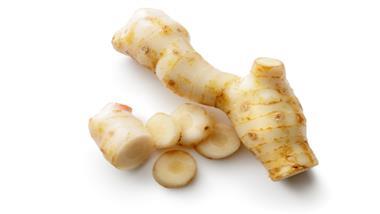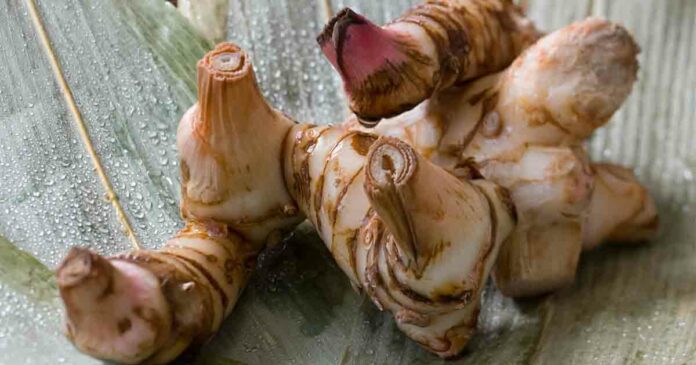Galangal’s health benefits and culinary uses

Story at-a-glance
- Galangal is an herb that is widely used in Southeast Asian cuisine. It is available as fresh and dried roots, or powdered. But aside from its culinary significance, galangal is also revered for its health effects on numerous body conditions
- Galangal is used in various ways, mainly to alleviate mild conditions. It is believed to function as an anti-emetic, carminative and anti-fungal agent
- While galangal is generally safe for human consumption, you should be aware that there are certain subgroups of the population that should limit their intake of this herb
Galangal is an herb that is widely used in Southeast Asian cuisine. It is available as fresh and dried roots, or powdered. But aside from its culinary uses, galangal is also revered for its health effects on numerous body conditions.1 Scientific studies have shown that galangal root has antimicrobial, antiparasitic2 and neuroprotective3 properties. Continue reading to learn more about galangal and how you can benefit from this herb.
What is galangal?
Ginger and turmeric are two of the most famous members of the Zingiberaceae family, but there’s a third noteworthy relative – galangal. The name “galangal” is used for three types of plants, which may make it confusing if you are not familiar with them. These three plants are referred to as greater galangal, lesser galangal or light galangal.4 This article will primarily focus on greater galangal, or Alpinia galanga.
Greater galangal, also known as Java galangal or Siamese ginger, originates from Southeast Asia. It is mostly cultivated in Malaysia and Indonesia but may also be found in some parts of India. It is typically used in cooking, although its essential oil is also gaining a following because of the numerous active compounds it contains. It is well known for its effects on respiratory ailments, mainly in children.5,6
While there is no reliable documentation, it is believed to be used by millions of people, with the majority growing galangal on their own.7 Galangal is a perennial herb that can grow up to 2 meters. It grows fragrant greenish-white flowers and small red fruits, reminiscent of cherries.8
Galangal benefits you may get
Because of the numerous active compounds of galangal, this herb can cater to numerous body systems. Some of the mechanisms in which galangal functions include helping:9
• Eliminate bacteria — In a 2006 study from LWT – Food Science and Technology, the ethanol extracts of galangal were found to have antimicrobial properties by interfering with the cytoplasm of bacteria and causing damage in both their external and internal membrane.10
Galangal may even help fight urinary tract infections. A 2019 study from Medicina showed that galangal extracts, together with A. calamus, A. rusticana and C. spinosa, can control the proliferation of uropathogens. The plant’s tuber contains α-humulene, pentadecade and 1’acetoxyeugenol acetate, which lend it its antimicrobial and antioxidant characteristics.11
• Ward off pests and parasites — A 2010 study from the Indian Journal of Experimental Biology showed that together with hexane and chloroform, extracts of galangal had significant antileishmanial activities in vitro.12
• Protect brain function — A 2011 study from the journal Phytotherapy Research showed that the extracts of galangal may have an antiamnesiac effect through its antioxidant effect on the brain.13 A more recent animal study done in 2019 from the Current Developments in Nutrition showed that galangal’s 1’acetoxychavicol acetate (ACA) helps curb age-related spatial memory deterioration and improve cognitive function.14
Galangal may also provide better mental alertness. A 2017 study from the Journal of the American College of Nutrition delved into the possible psychostimulant properties of galangal. Participants were given caffeine, a placebo or galangal extract separately, with the galangal group showing better mental awareness without the caffeine crash that usually accompanies caffeine intake.15
Galangal versus ginger
Since they’re both members of the Zingiberaceae family, galangal and ginger are consistently compared with each other. While galangal and ginger have slight similarities in both taste and appearance – people note that galangal has a slightly gingery taste, albeit a stronger flavor – they have their own individual characteristics that let them shine on their own.
According to the Huffington Post, the distinct taste of galangal gives Thai curry its signature flavor, with the writer stating that while ginger can be used as an alternative, galangal is still required to achieve the authentic flavor of the dish.16
People have described galangal as having a flowery flavor, much like ginger but with a hint of cardamom, while others note that it’s similar to cinnamon.17 Ginger, on the other hand, is often described as hot and spicy, but with a slight sweetness. It can be used for various recipes, sweet and savory alike.18
What are the uses of galangal?
Galangal is used in various ways, mainly to alleviate mild conditions. It is believed to function as an anti-emetic, carminative and anti-fungal agent. It is also said to improve appetite and relieve rheumatic pain.19 Together with the other galangal varieties, greater galangal may be used in perfumes, condiments, beers, wines and teas.20
Growing galangal: Is it possible?
Galangal is relatively easy to grow, as long as you meet the optimal growing conditions for it. According to Gardening Know How, galangal thrives in areas with partial shade and fertile, well-drained soil. Rhizomes available in the market may be planted to give rise to new plants. You can either plant the whole rhizome or cut it up into smaller pieces. However, make sure that you keep at least two “eyes” in each piece that you cut.
The rhizomes should be planted 2 to 3 inches away from each other. The soil you should be using shouldn’t be too soggy as this might cause the rhizomes to rot. After planting, the rhizomes should be ready for harvest in 10 to 12 months.21
How to store galangal
If you’re an avid fan of fresh produce, one of the most important things you should know about is proper storage. To choose the best galangal rhizome, make sure that to look for those that are ivory white and firm. Do not choose rhizomes that are already shriveled up. You can store galangal rhizomes in the refrigerator unwrapped for up to three weeks. Just make sure that you don’t cut them prior to storing.22
Keep an eye out for these galangal contraindications
While galangal is generally safe for human consumption, you should be aware that there are certain subgroups of the population that should limit their intake of this herb. People taking hemostatic medications should avoid galangal as it might magnify the effects of the drugs. There haven’t been enough studies done on galangal’s safety for pregnant women, so it would be best to consult your doctor before eating foods loaded with this herb.23
Frequently asked questions about galangal
Q: Where can you buy galangal?
A: It may be slightly challenging to come across fresh galangal, but if you’re in luck, you may find it at your local health food stores, or you can try ordering online. Just make sure that you verify the quality of the produce before ordering.
Q: What can I substitute for galangal?
A: Ginger can be used as a galangal alternative, seeing as they both belong to the same family. Some people note that galangal and ginger taste slightly similar to each other, with galangal having a much stronger flavor. Light galangal may also be used in exchange for this herb.24
Q: Is galangal the same as turmeric?
A: No. Galangal is different from turmeric. You can easily differentiate between the two through the difference in their colors. Galangal is white or yellowish-white white turmeric is yellowish-orange.25
Q: What does galangal look like?
A: Compared to ginger and turmeric, galangal has a paler and smoother skin.26 The rhizomes are cylindrical in shape and usually have multiple “branches.”27
Q: Does galangal need to be peeled?
A: It depends. In an article from Fine Cooking, galangal is best unpeeled when it is added to soups, but peeled when preparing pastes.28
Q: Can you eat galangal?
A: Yes. Galangal is widely used in Southeast Asian cooking. Fresh galangal can be grated or thinly sliced. It’s a common ingredient in laksa and curry.29
Sources and References
- 1, 5, 7 Handbook of Herbs and Spices, 2, 2012
- 2 International Journal of Biology; Vol. 7, No. 3; 2015
- 3, 13 Phytother Res. 2011 Jul;25(7):1061-7
- 4, 6, 24 Encyclopedia of Food Sciences and Nutrition, 2003
- 8 IJPSR, 2014; Vol. 5(4): 1449-1453
- 9 3 Biotech. 2013 Jun; 3(3): 173–185
- 10 LWT – Food and Science and Technology 39(10), 2006
- 11 Medicina 2019, 55(6), 289
- 12 Indian J Exp Biol. 2010 Mar;48(3):314-7
- 14 Curr Dev Nutr. 2019 Jun; 3
- 15 J Am Coll Nutr. 2017 Nov-Dec;36(8):631-639
- 16 Huffington Post, 2012
- 17 University of California Los Angeles, Greater Galangal
- 18 Ginger: A functional herb, 2013
- 19 Der Pharmicia Sinica, 2011, 2(1): 142:154
- 20 UCLA History & Special Collections, Greater Galangal
- 21 Gardening Know How, Galangal Plant Info – Learn About Galangal Plant Care and Usage
- 22 WebMD, Vegetable of the Month: Rhizomes – Gingerroot, Galangal, Turmeric
- 23 Drugs.com, Galangal
- 25 WebMD, Vegetable of the Month
- 26 The Kitchn, What’s the difference between galangal and ginger?
- 27 Indian Journal of Natural Products and Resources, 2010, 1(2)
- 28 Fine Cooking, Galangal
- 29 Smithsonian.com, What the heck do I do with galangal?

